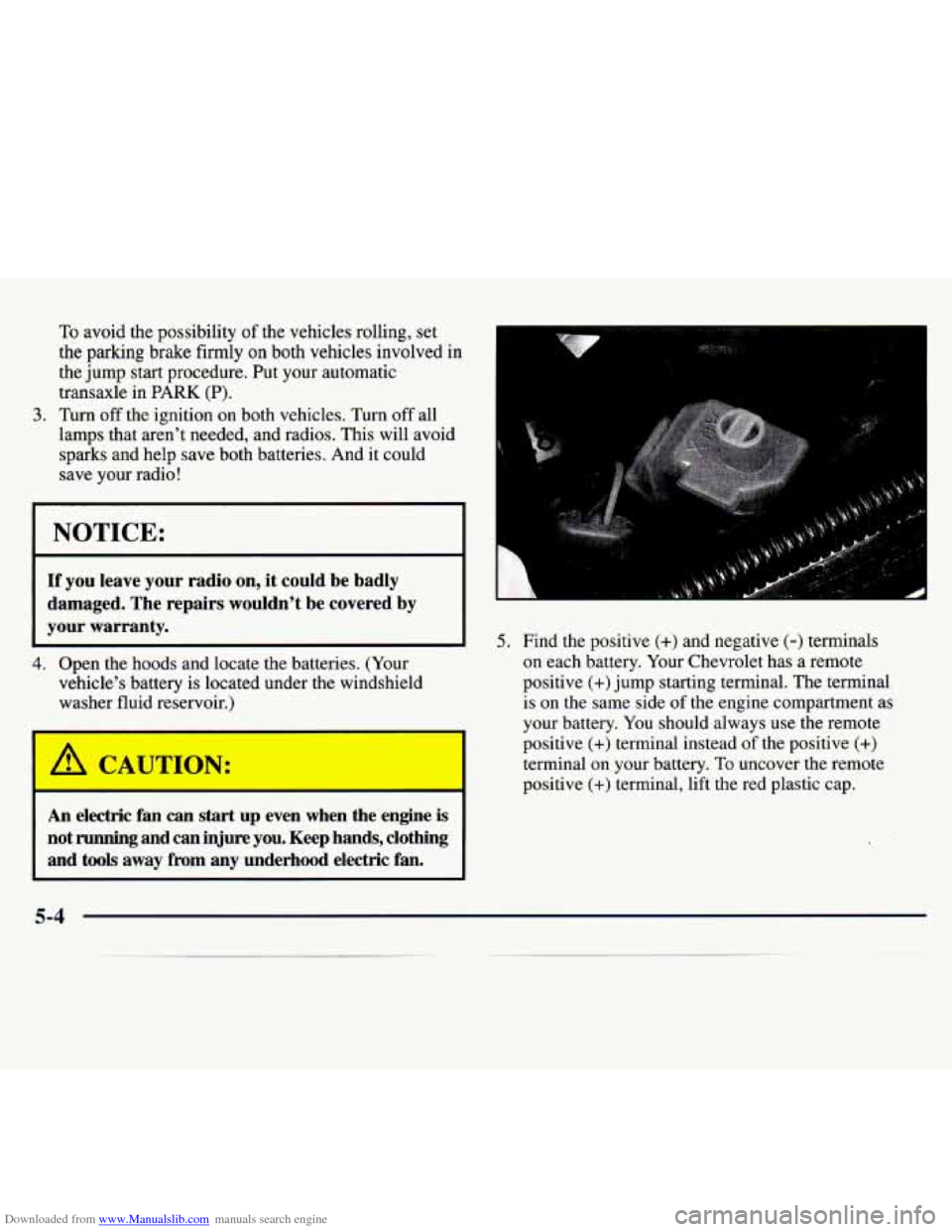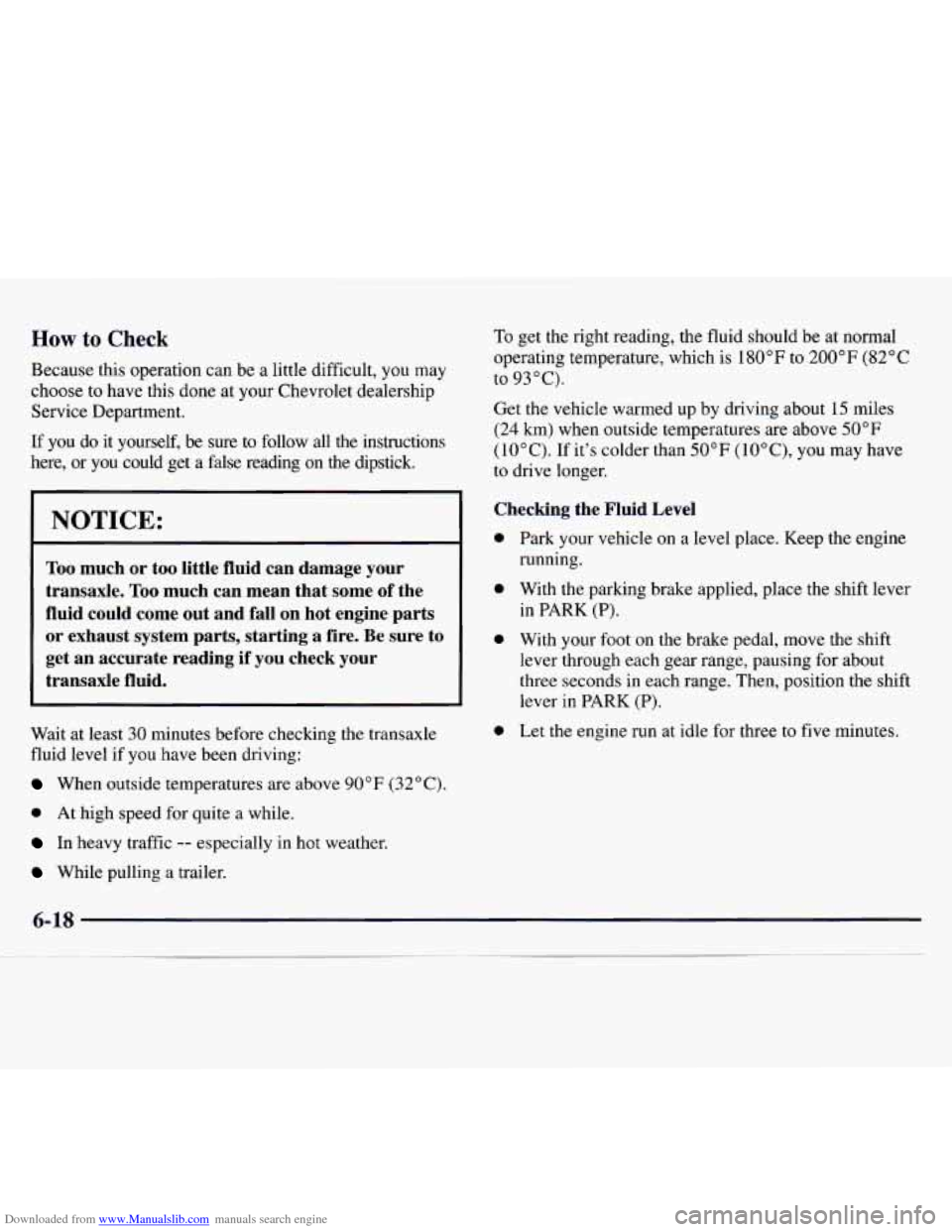Page 162 of 358

Downloaded from www.Manualslib.com manuals search engine If you drive regularly in steep country, or if you're
planning to visit there, here are some tips that can make
your trips safer and more enjoyable.
0 Keep your vehicle in good shape. Check all fluid
levels and also the brakes, tires, cooling system
and transaxle. These parts can work hard on
mountain roads.
Know how to go down hills. The most important
thing to know is this: let your engine do some of the
slowing down. Shift to a lower gear when you go
down
a steep or long hill.
If you don't shift down, your brakes could
get
so hot that they wouldn't work well. You
would then have poor braking or even none going
down a hill. You could crash. Shift down to let
your engine assist your brakes on a steep
downhill slope. Coasting downhill in
NEUTRAL (N) or
with the
ignition
off is dangerous. Your brakes will have to
do all the work of slowing down. They could get
so
hot that they wouldn't work well. You would then
have poor braking or even none going down
a hill.
You could crash. Always have your engine running
and your vehicle
in gear when you go downhill.
0
0
0
0
Know how to go uphill. You may want to shift down
to a lower gear. The lower gears help cool your engine and transaxle, and
you can climb the hill better.
Stay in your own lane when driving on two-lane
roads in hills or mountains. Don't swing wide or cut
across the center
of the road. Drive at speeds that let
you stay in your own lane.
As you go over the top of a hill, be alert. There could be
something in your lane, like a stalled car or an accident.
You may see highway signs
on mountains that warn of
special problems. Examples are long grades, passing or
no-passing zones, a falling rocks area or winding
roads. Be alert
to these and take appropriate action.
Page 176 of 358
Downloaded from www.Manualslib.com manuals search engine When You Are Ready to Leave After
Parking on a
Hill
1. Apply your regular brakes and hold the pedal down
while you:
0 Start your engine;
0 Shift into a gear; and
Release the parking brake.
2. Let up on the brake pedal.
3. Drive slowly until the trailer is clear of the chocks.
4. Stop and have someone pick up and store the chocks.
Maintenance When Trailer Towing
Your vehicle will need service more often when you’re
pulling a trailer. See the Maintenance Schedule for more
on this. Things that are especially important in trailer
operation are automatic transaxle fluid (don’t overfill),
engine oil, belt, cooling system and brake adjustment.
Each
of these is covered in this manual, and the Index
will help
you find them quickly. If you’re trailering, it’s
a
good idea to review these sections before you start
your trip.
Check periodically
to see that all hitch nuts and bolts
are tight.
Page 181 of 358

Downloaded from www.Manualslib.com manuals search engine To avoid the possibility of the vehicles rolling, set
the parking brake firmly on both vehicles involved in
the jump start procedure. Put your automatic
transaxle in
PARK (P).
lamps that aren't needed, and radios. This will avoid
sparks and help save both batteries.
And it could
save your radio!
3. Turn off the ignition on both vehicles. Turn off all
NOTICE:
If you leave your radio on, it could be badly
damaged. The repairs wouldn't be covered by
your warranty.
4. Open the hoods and locate the batteries. (Your
vehicle's battery is located under the windshield
washer fluid reservoir.)
An electric fan can start up even when the engine is
not running and can injure you. Keep hands, clothing
and tools away from any underhood electric fan.
1
I
5. Find the positive (+) and negative (-) terminals
on each battery. Your Chevrolet has a remote
positive (+)jump starting terminal. The terminal
is on the same side
of the engine compartment as
your battery. You should always use the remote
positive
(+) terminal instead of the positive (+)
terminal on your battery. To uncover the remote
positive
(+) terminal, lift the red plastic cap.
Page 216 of 358

Downloaded from www.Manualslib.com manuals search engine 0 Section 6 Service and Appearance Care
Here you will find information about the care of your Chevrolet. This section begins with service and fuel
information, and then
it shows how to check important fluid and lubricant levels. There is also technical information
about your vehicle, and a part devoted to its appearance care.
6-2
6-3
6-4 6-5
6-7 6- 10
6-16
6- 17
6-20
, 6-24 6-25
6-27
6-30
6-3
1
6-3 1
6-37 6-37 6-45
Service
Fuel
Fuels in Foreign Countries
Filling Your Tank
Checking Things Under the Hood
Engine Oil
Air Cleaner
Automatic Transaxle Fluid
Engine Coolant
Power Steering Fluid
Windshield Washer Fluid
Brakes Battery
Bulb Replacement
Halogen Bulbs
Windshield Wiper Blade Replacement
Tires
Appearance Care 6-46
6-50
6-50
6-50
6-50 6-5 1
6-52 6-52
6-5
2
6-5 3 6-5 3
6-53 6-54
6-55
6-55
6-56
6-65
Cleaning the Inside of Your Chevrolet
Care
of Safety Belts
Cleaning Glass Surfaces
Cleaning the Outside of
the Windshield and
Wiper Blades
Weatherstrips
Cleaning the Outside of Your Chevrolet
Cleaning Aluminum Wheels (If Equipped)
Cleaning Tires Sheet Metal Damage
Finish Damage
Underbody Maintenance
Chemical Paint Spotting
Appearance Care Materials Chart
Vehicle Identification Number (VIN)
Service Parts Identification Label
Electrical System
Air Conditioning Refrigerants
6-1
Page 222 of 358
Downloaded from www.Manualslib.com manuals search engine 'ION:
Things that burn can get on hot engine parts and
start
a fire. These include liquids like gasoline,
oil, coolant, brake fluid, windshield washer and
other fluids, and plastic
or rubber. You or others
could be burned. Be careful not to drop or spill
things that will burn onto a hot engine.
Hood Release
To open the hood, first pull
the handle located inside the
vehicle near the parking
brake pedal. Then
go to the front of the vehicle and release
the
secondary
hood release. Lift the hood.
Page 223 of 358
Downloaded from www.Manualslib.com manuals search engine When you open the hood on the 3 100 (Code M) engine, you'll see:
j_
t
A. Engine Coolant Reservoir
B. Radiator Fill Cap
C. Power Steering Fluid Reservoir
D. Engine Oil Fill Cap
E. Engine Oil Dipstick
F. Automatic Transaxle
G. Brake Fluid Reservoir
H. Air Filter
I. Remote Positive
Battery Terminal Fluid Dipstick
J. Windshield Washer
Fluid Reservoir
K. Battery (located under
Windshield Washer
Fluid Reservoir)
6-8
Page 224 of 358
Downloaded from www.Manualslib.com manuals search engine When you open the hood on the 3.4L DOHC (Code X) engine, you’ll see:
r
.FA
A. Engine Coolant Reservoir F. Automatic Transaxle -
B. Radiator Fill Cap
C. Power Steering Fluid Reservoir
D. Engine Oil Fill Cap
E. Engine Oil Dipstick Fluid Dipstick
G. Brake
Fluid Reservoir
H. Air Filter
I. Remote Positive
Battery Terminal
J. Windshield Washer
Fluid Reservoir
K. Battery (located under
Windshield Washer Fluid Reservoir)
6-9
Page 233 of 358

Downloaded from www.Manualslib.com manuals search engine How to Check
Because this operation can be a little difficult, you may
choose to have this done at your Chevrolet dealership
Service Department.
If you do it yourself, be sure to follow all the instructions
here,
or you could get a false reading on the dipstick.
NOTICE:
Too much or too little fluid can damage your
transaxle.
Too much can mean that some of the
fluid could come out and fall on hot engine parts
or exhaust system parts, starting a fire. Be sure to
get an accurate reading if you check your
transaxle fluid.
Wait at least 30 minutes before checking the transaxle
fluid level if you have been driving:
When outside temperatures are above 90 "F (32°C).
0 At high speed for quite a while.
In heavy traffic -- especially in hot weather.
While pulling a trailer.
To get the right reading, the fluid should be at normal
operating temperature, which is
180°F to 200°F (82°C
to
93°C).
Get the vehicle warmed up by driving about 15 miles
(24 km) when outside temperatures are above 50°F
(10°C). If it's colder than 50°F ( 10°C), you may have
to drive longer.
Checking the Fluid Level
0
0
0
0
Park your vehicle on a level place. Keep the engine
running.
With the parking brake applied, place the shift lever
in PARK
(P).
With your foot on the brake pedal, move the shift
lever through each gear range, pausing for about
three seconds in each range. Then, position the shift
lever in PARK (P).
Let the engine run at idle for three
to five minutes.